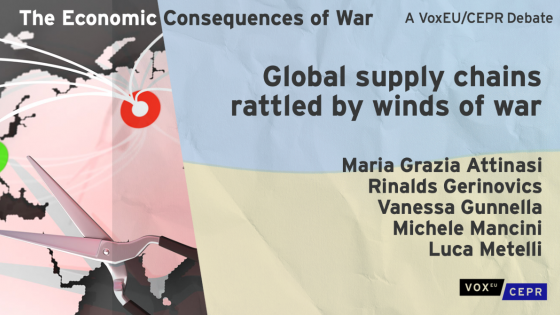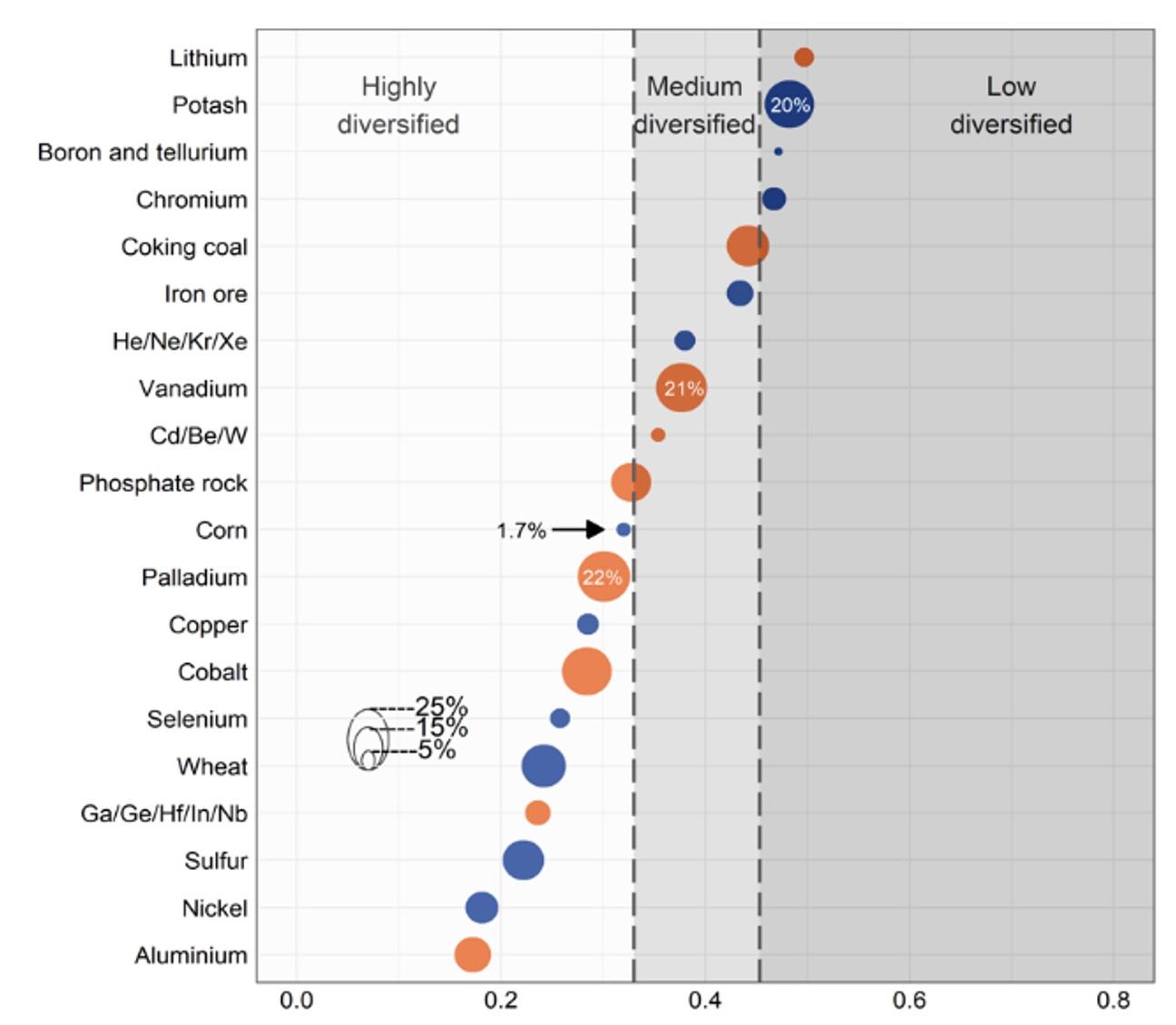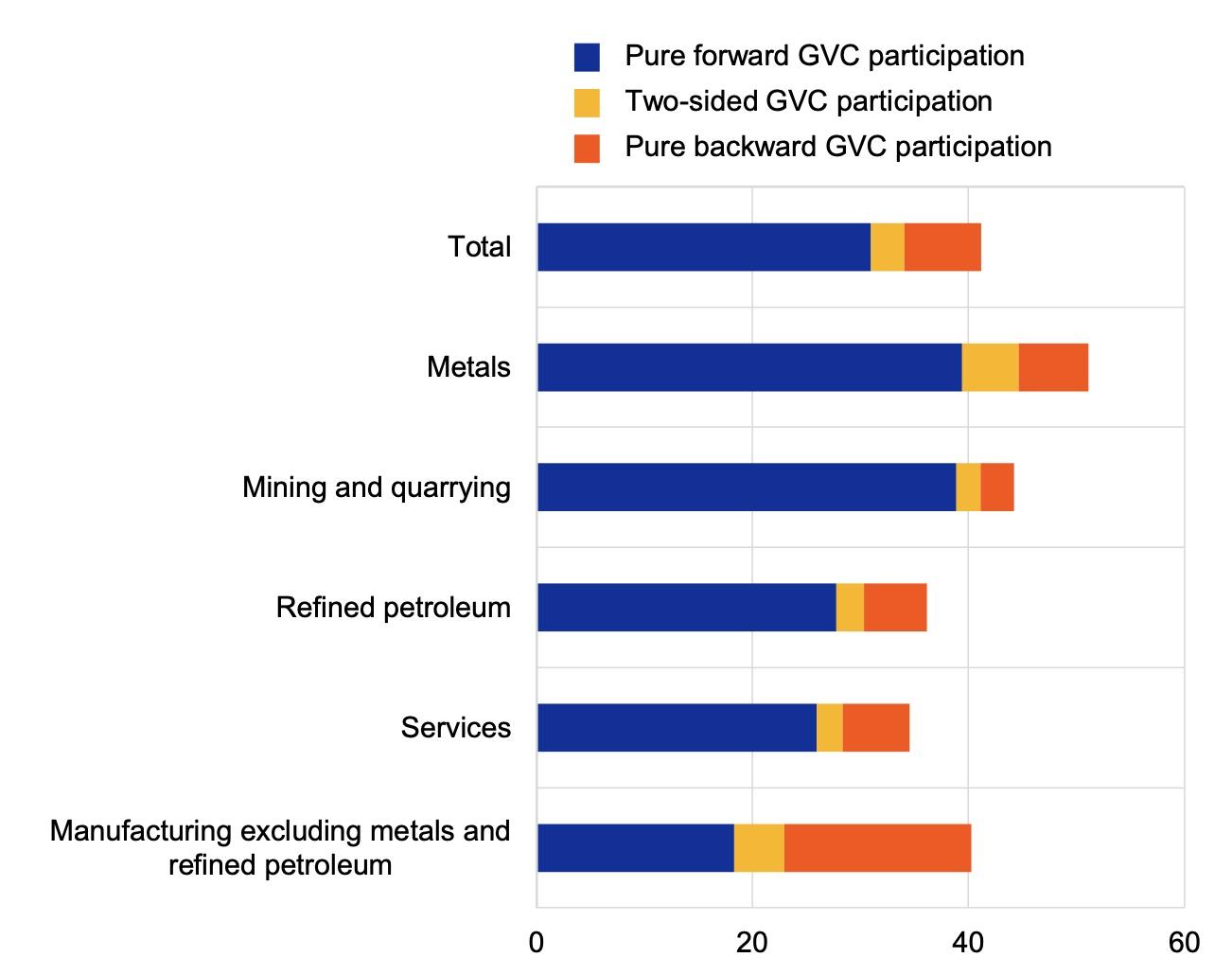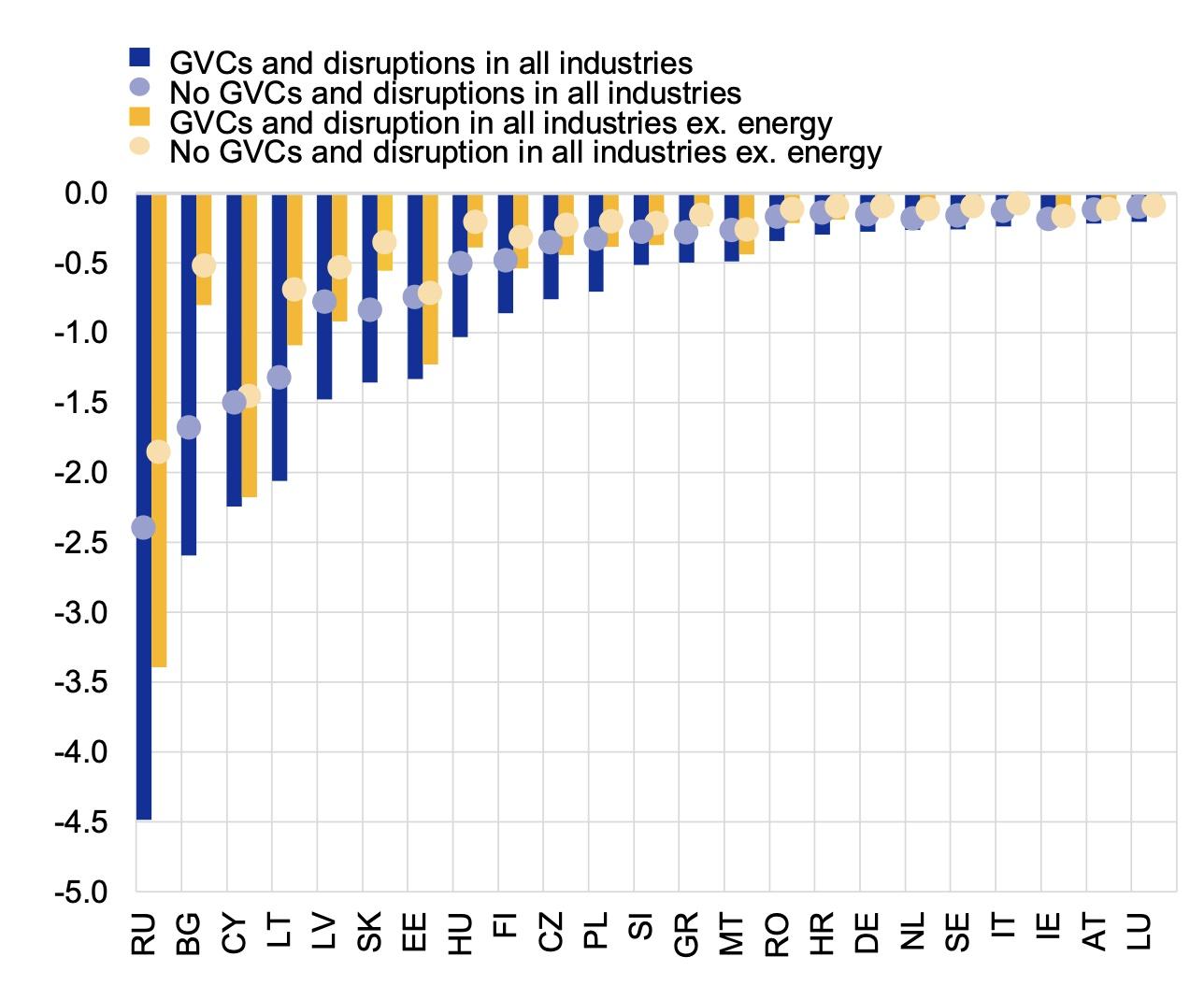Supply bottlenecks have worsened since the onset of the war, especially in sectors largely dependent on Russia’s and Ukraine’s exports. We construct a new index of global sectoral supply chain pressures (GSSP) which disentangles the contributions of seven industries to aggregate supply pressures in the manufacturing sector. This indicator is derived from a vector auto-regression (VAR) with global purchasing managers’ index (PMI) variables such as: output, output prices, and the suppliers’ delivery times of seven manufacturing sectors. A global supply shock is identified through sign restrictions and the indicator is obtained bottom-up by aggregating the fluctuations in sectoral PMI suppliers’ delivery times (SDT) that are explained by the global supply shock.1 The GSSP indicator suggests that supply pressures intensified again since March (Figure 1), with the natural resources and chemical industries sectors being the main contributors. This pattern of sectoral disruptions likely reflects the impact of the war in Ukraine, as both Russia and Ukraine are important exporters of metals and mining products, as well as products used in the production of fertilizers (i.e. the chemicals sector).2 Such supply disruptions, not yet fully captured by available economic data, are likely to intensify in the next few months, especially in Europe.
Figure 1 Supply chain pressure indicator in global manufacturing
(standard deviations from the average value and point contributions)
Sources: IHS Markit and authors’ calculations. Latest observation: April 2022.
Notes: Left (right) hand side panel is aggregated at quarterly (monthly) frequency. Higher values of the indicator point to worsening in the supply chain pressures.
Figure 2 Russia’s share in global exports of raw materials and degree of export market concentration
(share in world’s exports; Herfindahl-Hirschman index; 2019)
Source: Trade Data Monitor, European Commission and authors’ calculations.
Notes: Materials marked with red circles denote strategic raw materials as defined by the European Commission’s latest criticality assessment (2020 Factsheets). The size of the bubbles refers to share of Russia in global exports.
Looking at Russia’s trade specialisation is useful to assess the potential implications of war-related disruptions for global supply chains and their geographical dimension. Russia’s exports of oil, gas, and coal account for 15% of the world’s exports of these commodities and the EU is its largest importer and the region with the highest import dependence from Russia. This explains the supply pressures emerging in the natural resources sector. In addition to energy commodities, Russia is also a key exporter of raw materials, including those classified by the European Commission (2020) as critical given their economic importance and high supply risks (Figure 2). For example, Russia exports materials used in the production of fertilisers, especially potash, where it has a dominant position, but also of sulphur and phosphate rocks. When looking at critical raw materials, Russia is a large exporter of palladium, vanadium, and cobalt, which are most prominently used in the production of 3D printing, drones, robotics industries, batteries, and semiconductors, thus affecting also other sectors, such as electronic appliances, transportation, and most prominently the car sector. Russia is also the fourth largest producer of coking coal, used for steel production, where it also enjoys a dominant market position, while Ukraine is one of the largest exporters of iron ore, which is used in iron and steel industries.
War-related disruptions to production and trade flows from Russia may be amplified through global production networks given the country’s significant forward integration in global value chains. Russia’s share in global forward global value chains participation is around double the size of its share in gross global trade (2.8% versus 1.5%). Notably, Russia has one of the highest forward participation rates in supply chains, as more than 30% of its exports consist of inputs used by its trade partners as intermediate inputs, compared to a global average of just 18% (Figure 3). This is explained by Russia’s specialisation in energy and metal industries, which are intrinsically more forward integrated, being positioned upstream in the production process. Therefore, disruptions to Russia’s exports might well propagate downstream through supply chain networks, having an impact also via the indirect trade (Winkler and Wuester 2022, Winkler et al. 2022). Moreover, as Russian inputs are involved in several stages of production, implications of disruptions could potentially be long-lasting, in line with previous firm-level empirical evidence based on the Tohoku earthquake (Boehm et al. 2019).
Quantitative trade models which account for global value chain linkages find that the size of the welfare effects of trade disruptions due to the war is double compared to standard models. In a recent work (Borin et al. 2022) a multi-sector, multi-country general equilibrium trade model (Antràs and Chor, 2018) is exploited to gauge to what extent supply chains may amplify the effects of the collapse in trade between Russia and its trading partners. A decline in Russian imports from sanctioning countries in line with the most recent trade data is obtained through an increase in bilateral trade barriers. The results suggest that Russia and some EU countries, most notably Central and Eastern European countries and Finland, would be affected disproportionally compared to others, with the welfare effects being significantly larger when sanctions on energy are assumed, suggesting a highly pervasive role for energy inputs in production (Figure 3). Indirect cross-country and cross-sectoral linkages effects act as a significant magnifier, as they double the size of the standard (i.e. non-global value chain) effects, especially for those countries which have tighter supply chain linkages with Russia. One caveat to these findings is that the quantitative trade model features a high degree of substitutability across inputs, a feature arguably unrealistic especially in the short run for critical inputs such as energy (Bachmann et al. 2022). Under lower but plausible degree of substitutability, Borin et al. (2022) show that the magnitude of the effects on economic activity of disruptions to trade in energy products would be higher than estimated above and, in the case of a full energy embargo, they would increase markedly and may reach 4% of GDP in the euro area.
Figure 3 Russia’s participation in global value chains across sectors by different modes
(percentage share of total exports, 2020)
Sources: World Bank WITS, ADB MRIO tables.
Notes: Measures are based on Borin et al. (2021).
Figure 4 Amplification effects of global value chains
(GDP changes, percentages)
Source: Borin et al. (2022).
Notes: The model with GVCs relies on a full input-output structure. The model without GVCs utilizes an altered input-output structure where trade in intermediate products is attributed to trade in final products. Data refers to 2018. Only countries where welfare changes are larger than 0.2% are reported.
References
Antràs, P and D Chor (2018), “On the Measurement of Upstreamness and Downstreamness in Global Value Chains”, In L Y Ing and M Yu (eds.), World Trade Evolution: Growth, Productivity and Employment, London, UK: Routledge, Chapter 5.
Bachmann, R, D Baqaee, C Bayer, M Kuhn, A Löschel, B Moll, A Peich, K Pittel and M Schularick (2022), “What if? The Economic Effects for Germany of a Stop of Energy Imports from Russia”, Working Paper.
Borin, A, F P Conteduca, E Di Stefano, V Gunnella, M Mancini and L Panon (2022), “Quantitative assessment of the economic impact of the trade disruptions following the Russian invasion of Ukraine”, Occasional Paper Series, Banca d’Italia, forthcoming.
Borin, A, M Mancini and D Taglioni (2021), “Measuring Exposure to Risk in Global Value Chains”, World Bank Policy Research Working Paper No. 9785.
Boehm, C E, A Flaaen and N Pandalai-Nayar (2019), “Input linkages and the transmission of shocks: Firm-level evidence from the 2011 Tōhoku earthquake”, Review of Economics and Statistics 101(1): 60-75.
European Commission (2020), “Critical Raw Materials Resilience: Charting a Path towards greater Security and Sustainability”.
Winkler, D, L Wuester and D Knight (2022), “The effects of Russia’s global value chain participation”, in M Ruta (ed.), The Impact of the War in Ukraine on Global Trade and Investment, The World Bank.
Winkler, D and L Wuester (2022), “Implications of Russia’s invasion of Ukraine for its value chains”, VoxEU.org, 11 May.
Endnotes
1 The indicator is obtained by aggregating the fluctuations of the sectoral PMI delivery times which are due to the global supply shock. These sectoral fluctuations are weighted by the relevance of various sectors in the global economy. The indicator compares well with the indicator GSCPI produced by the NY Fed, sharing a high degree of correlation (around 90%). The sectors considered in the indicator are Chemicals, Natural resources, Automobiles & Auto parts, Food and Beverages, Household & Personal Use Products, Industrial goods, and Technological Equipment.
2 Our indicator likely picks up also the effects of the severe lockdown measures introduced in China since mid-March in response to the spread of the Omicron variant, and which caused disruptions to economic activity and logistics.












